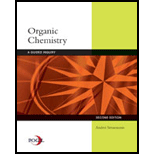
Concept explainers
Interpretation: The parent name in each chemical name given below should be underlined.

Concept introduction: Systematic way to name different organic compounds is
Rules for nomenclature of
1 The longest continuous carbon chain is identified first and named in accordance with number of carbon atoms present in it. For example, hydrocarbon with one carbon atom has prefix “meth”, that with two carbon atoms has prefix “eth”, that with three carbon atoms has prefix “prop” and so on. Suffix used for alkanes is “ane.”
2. Substituents attached to parent carbon chain are to be identified. These are named by removal of single hydrogen atom from carbon chain end and named by replacement of suffix “ane” by “yl.” For example if
3. Carbons of parent chain are named in such way that substituents acquire the lowest numbers.
4. If same substituent is present more than one time in molecule, it is represented by prefix “di”, “tri” and so on. It depends on number of times substituent occurs in molecule.
5. If two or more substituents are present in molecule, these are named in alphabetical order.
6. If carbon chains of same length exist in same molecule, chain with the largest number of side chains, followed by lowest number to substituents, chain with the greatest number of carbon atoms in smaller chain and chain with the least branched side chains are preferred over other ones.
7. Prefix “cyclo” is used if cyclic alkane is present in molecule.
Want to see the full answer?
Check out a sample textbook solution
Chapter NW1 Solutions
Organic Chemistry: A Guided Inquiry
- presented by Morallen Lig Intermine the hand product for the given mution by adding atoms, bonds, nonhonding diarion panda скуль Step 3: Comp the draw the product Step 2: Agama workup Compithe 429 ملولةarrow_forwardReaction A 0,0arrow_forwardpresented by Morillon Leaning Predict the organic product for the min кусур HSC Adithane carved arnown to come than that to the condon slchroruis in acid in in aquishri with ноюarrow_forward
- 6.15PM Sun Mar 30 K Draw the major product of this reaction. Include any relevant stereochemistry. Ignore inorganic byproducts. Problem 1 of O H [PhзPCH2CH3]*C|¯ NaH Drawing > Q Atoms, Bonds and Draw or tap a nearrow_forward8:17 PM Sun Mar 30 Draw the major product of this reaction. Ignore inorganic byproducts. HSCH2CH2CH2SH, BF3 Probler Drawing Ato Bonds Clarrow_forwardpresented by Mr L How the coprion. (Il Done in no wraction, dew the starting redential) доarrow_forward
- 8:16 PM Sun Mar 30 K Draw the major product of this reaction. Ignore inorganic byproducts. Proble 1. CH3MgBr 2. H3O+ F Drawingarrow_forwardо но оarrow_forwardName the major organic product of the following action of 4-chloro-4-methyl-1-pentanol in neutral pollution 10+ Now the product. The product has a molecular formula f b. In a singly hain, the starting, material again converts into a secule with the molecular kormula CIO. but with comply Draw the major organic structure inhalationarrow_forward
- Macmillan Learning Alcohols can be oxidized by chromic acid derivatives. One such reagent is pyridinium chlorochromate, (C,H,NH*)(CICTO3), commonly known as PCC. Draw the proposed (neutral) intermediate and the organic product in the oxidation of 1-butanol by PCC when carried out in an anhydrous solvent such as CH₂C₁₂. PCC Intermediate OH CH2Cl2 Draw the intermediate. Select Draw Templates More с H Cr о Product Draw the product. Erase Select Draw Templates More H о Erasearrow_forwardIf I have 1-bromopropene, to obtain compound A, I have to add NaOH and another compound. Indicate which compound that would be. A C6H5 CH3arrow_forwardProvide the reagents for the following reactions.arrow_forward
 Organic Chemistry: A Guided InquiryChemistryISBN:9780618974122Author:Andrei StraumanisPublisher:Cengage Learning
Organic Chemistry: A Guided InquiryChemistryISBN:9780618974122Author:Andrei StraumanisPublisher:Cengage Learning
